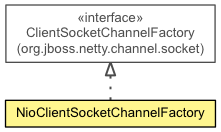
- java.lang.Object
-
- org.jboss.netty.channel.socket.nio.NioClientSocketChannelFactory
-
- All Implemented Interfaces:
- ChannelFactory, ClientSocketChannelFactory, ExternalResourceReleasable
public class NioClientSocketChannelFactory extends Object implements ClientSocketChannelFactory
AClientSocketChannelFactorywhich creates a client-side NIO-basedSocketChannel. It utilizes the non-blocking I/O mode which was introduced with NIO to serve many number of concurrent connections efficiently.How threads work
There are two types of threads in a
NioClientSocketChannelFactory; one is boss thread and the other is worker thread.Boss thread
One
NioClientSocketChannelFactoryhas one boss thread. It makes a connection attempt on request. Once a connection attempt succeeds, the boss thread passes the connectedChannelto one of the worker threads that theNioClientSocketChannelFactorymanages.Worker threads
One
NioClientSocketChannelFactorycan have one or more worker threads. A worker thread performs non-blocking read and write for one or moreChannels in a non-blocking mode.Life cycle of threads and graceful shutdown
All threads are acquired from the
Executors which were specified when aNioClientSocketChannelFactorywas created. A boss thread is acquired from thebossExecutor, and worker threads are acquired from theworkerExecutor. Therefore, you should make sure the specifiedExecutors are able to lend the sufficient number of threads. It is the best bet to specify a cached thread pool.Both boss and worker threads are acquired lazily, and then released when there's nothing left to process. All the related resources such as
Selectorare also released when the boss and worker threads are released. Therefore, to shut down a service gracefully, you should do the following:- close all channels created by the factory usually using
ChannelGroup.close(), and - call
releaseExternalResources().
RejectedExecutionExceptionand the related resources might not be released properly.
-
-
Constructor Summary
Constructors Constructor and Description NioClientSocketChannelFactory()Creates a newNioClientSocketChannelFactorywhich usesExecutors.newCachedThreadPool()for the worker and boss executors.NioClientSocketChannelFactory(BossPool<NioClientBoss> bossPool, WorkerPool<NioWorker> workerPool)Creates a new instance.NioClientSocketChannelFactory(Executor bossExecutor, Executor workerExecutor)Creates a new instance.NioClientSocketChannelFactory(Executor bossExecutor, Executor workerExecutor, int workerCount)Creates a new instance.NioClientSocketChannelFactory(Executor bossExecutor, Executor workerExecutor, int bossCount, int workerCount)Creates a new instance.NioClientSocketChannelFactory(Executor bossExecutor, int bossCount, WorkerPool<NioWorker> workerPool)Creates a new instance.NioClientSocketChannelFactory(Executor bossExecutor, int bossCount, WorkerPool<NioWorker> workerPool, Timer timer)Creates a new instance.
-
Method Summary
Methods Modifier and Type Method and Description SocketChannelnewChannel(ChannelPipeline pipeline)voidreleaseExternalResources()Releases the external resources that this factory depends on to function.voidshutdown()Shudown the ChannelFactory and all the resource it created internal.
-
-
-
Constructor Detail
-
NioClientSocketChannelFactory
public NioClientSocketChannelFactory()
Creates a newNioClientSocketChannelFactorywhich usesExecutors.newCachedThreadPool()for the worker and boss executors. SeeNioClientSocketChannelFactory(Executor, Executor)
-
NioClientSocketChannelFactory
public NioClientSocketChannelFactory(Executor bossExecutor, Executor workerExecutor)
Creates a new instance. Calling this constructor is same with callingNioClientSocketChannelFactory(Executor, Executor, int, int)with 1 and (2 * the number of available processors in the machine) for bossCount and workerCount respectively. The number of available processors is obtained byRuntime.availableProcessors().
-
NioClientSocketChannelFactory
public NioClientSocketChannelFactory(Executor bossExecutor, Executor workerExecutor, int workerCount)
Creates a new instance. Calling this constructor is same with callingNioClientSocketChannelFactory(Executor, Executor, int, int)with 1 as bossCount.
-
NioClientSocketChannelFactory
public NioClientSocketChannelFactory(Executor bossExecutor, Executor workerExecutor, int bossCount, int workerCount)
Creates a new instance.
-
NioClientSocketChannelFactory
public NioClientSocketChannelFactory(Executor bossExecutor, int bossCount, WorkerPool<NioWorker> workerPool)
Creates a new instance.- Parameters:
bossExecutor- theExecutorwhich will execute the boss threadbossCount- the maximum number of boss threadsworkerPool- theWorkerPoolto use to do the IO
-
NioClientSocketChannelFactory
public NioClientSocketChannelFactory(Executor bossExecutor, int bossCount, WorkerPool<NioWorker> workerPool, Timer timer)
Creates a new instance.- Parameters:
bossExecutor- theExecutorwhich will execute the boss threadbossCount- the maximum number of boss threadsworkerPool- theWorkerPoolto use to do the IOtimer- theTimerto use to handle the connection timeouts
-
NioClientSocketChannelFactory
public NioClientSocketChannelFactory(BossPool<NioClientBoss> bossPool, WorkerPool<NioWorker> workerPool)
Creates a new instance.- Parameters:
bossPool- theBossPoolto use to handle the connectsworkerPool- theWorkerPoolto use to do the IO
-
-
Method Detail
-
newChannel
public SocketChannel newChannel(ChannelPipeline pipeline)
Description copied from interface:ChannelFactory- Specified by:
newChannelin interfaceChannelFactory- Specified by:
newChannelin interfaceClientSocketChannelFactory- Parameters:
pipeline- theChannelPipelinewhich is going to be attached to the newChannel- Returns:
- the newly open channel
-
shutdown
public void shutdown()
Description copied from interface:ChannelFactoryShudown the ChannelFactory and all the resource it created internal.- Specified by:
shutdownin interfaceChannelFactory
-
releaseExternalResources
public void releaseExternalResources()
Description copied from interface:ChannelFactoryReleases the external resources that this factory depends on to function. An external resource is a resource that this factory didn't create by itself. For example,Executors that you specified in the factory constructor are external resources. You can call this method to release all external resources conveniently when the resources are not used by this factory or any other part of your application. An unexpected behavior will be resulted in if the resources are released when there's an open channel which is managed by this factory. This will also callChannelFactory.shutdown()before do any action- Specified by:
releaseExternalResourcesin interfaceChannelFactory- Specified by:
releaseExternalResourcesin interfaceExternalResourceReleasable
-
-